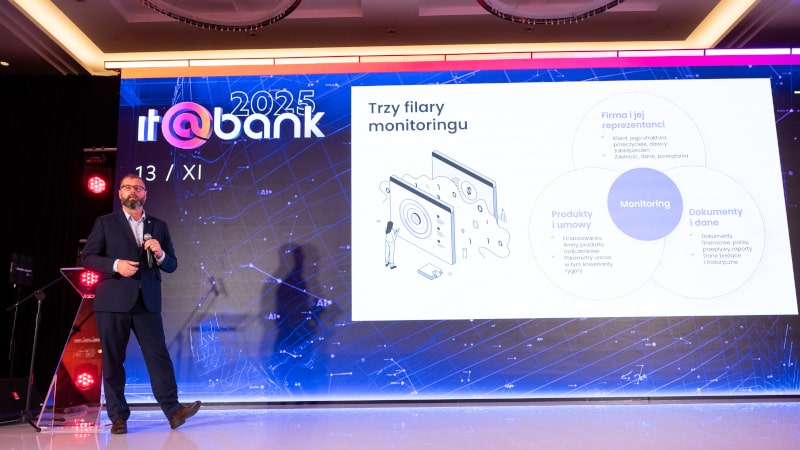Effective Monitoring of Corporate Clients — Why It’s Worth Investing in This Area
Many financial institutions still assess corporate credit risk in a point-in-time manner: during loan applications, selected operational activities, and periodic reviews. Today, that’s no longer enough. The economy moves faster than reporting cycles, and a single external shock can trigger a domino effect. Banks need to know what is happening with a client right now — not only when delays finally appear.
How Do We Build an Effective Corporate Client Monitoring Process? – A Summary of Our Presentation at IT@Bank 2025
On 13 November, we had the pleasure of partnering with the IT@Bank conference, where we shared our perspective on building an effective process for monitoring corporate clients. Our speaker, Jakub Rabong, walked the audience through what the post-sales journey looks like in practice, and what challenges banks face when data originating from a single agreement begins to live simultaneously across multiple systems.
When Risk Monitoring Loses Its Effectiveness – and How Banks Can Respond
In many financial institutions, corporate client monitoring still operates as a set of isolated actions rather than a continuous, integrated process. Data is scattered across multiple systems, credit ratings are updated with delays, and critical risk information does not always reach the right teams in time.
Modern Risk Management in Banking: Early Warning and Rating Systems
How can banks support their clients’ growth by financing their investments while simultaneously protecting themselves from the risk of financial loss? In banking, credit risk management is a top priority. Two key tools that help achieve this are the rating system and the Early Warning System (EWS). Each of them is effective on its own, but it is their combination that creates a powerful duo capable of protecting a loan portfolio from significant losses.
Why is it worth using AI for large-scale document processing?
Companies face a massive volume of documents requiring analysis every day. Traditional methods of manual data extraction not only consume valuable employee time but also generate high operational costs and increase the risk of errors. Advanced artificial intelligence systems such as VSoft AI Document Analyser are emerging as the solution to these challenges.
Loan Process Management System for Corporate Clients
In one of our projects for a major banking institution, we were tasked with designing a solution to support the entire credit process in all its complexity—from the initial offer to the disbursement of funds—for various types of corporate clients and decision-making paths.
How AI Automates the Handling of Court-Enforcement Documents
AI-based solutions play a crucial role in automating processes that were previously carried out manually. One example is the VAIDA system for handling court-enforcement documents, presented by Agata Zapała, Business Solutions Architect at VSoft SA.
Divortium & VSoft SA – WAD.TB as a Key Step in the Digitalization of Legal Data Analysis
Divortium, a company specializing in legal services and asset-related proceedings, was seeking a way to streamline and automate the analysis of banking data in court cases. The previous approach—manually reviewing hundreds of pages of bank statements—was time-consuming, costly, and prone to error. This challenge was taken on by the team at VSoft SA.
AI in Debt Collection: How to Harness the Potential of Artificial Intelligence in the Debt Recovery Process
Artificial intelligence has become an integral part of our everyday lives. Increasingly, people are turning to ChatGPT instead of traditional search engines, asking AI for weekend trip plans or jacket recommendations for a mountain hike. But the real revolution is still on the horizon—especially in the financial sector and receivables management. With the AI Act coming into effect, companies must not only recognize the potential of these new technologies but also develop strategies for their safe and legally compliant implementation.
Digitization in insurance: technological race or a real business-changing value?
Digitalization and new technologies have become a central topic in the insurance industry. Technological progress and growing customer expectations force companies to implement modern digital solutions. During each industry conference, experts, market leaders and innovators discuss their potential, looking for solutions to secure the future of the insurance sector. InsurTech technologies tempt with the promise of simplified processes and personalized offers and seem to be an ideal solution. However, it is worth remembering that it is not enough to simply follow trends.
How Automation and AI Are Transforming the Receivables Management Industry
Automation, artificial intelligence, and advanced digital tools are transforming processes related to receivables management. What’s driving these innovations, and what benefits do they bring to the debt collection industry? Debt collection processes, whose main objective is the effective recovery of overdue receivables, are undergoing a profound technological transformation. Modern solutions support all key aspects of these processes—from client communication and decision-making to the collection and updating of debtor information. The implementation of advanced technologies and AI significantly accelerates execution, especially in the area of customer interaction, directly improving the effectiveness of debt recovery. Automating these actions can also help significantly reduce operational costs.
Open Banking and APIs – From Necessity to Value
In recent years, the banking sector has undergone a significant transformation. One of the driving forces behind this change is Open Banking and APIs (Application Programming Interfaces). Initially introduced as a regulatory requirement under the PSD2 (Payment Services Directive 2), Open Banking enables bank customers to share their data with selected entities, including fintechs, in […]
New VSoft Projects: Leveraging AI in Receivables Management
Generative AI, which is taking the business world by storm, is also opening new possibilities in the field of receivables management. AI-based systems can analyze vast amounts of data, automate many repetitive tasks, and even predict debtor behavior. In this article, we present two innovative projects undertaken by VSoft's team: "Using OpenAI to Recognize Court Letters" and "Analyzing Messages for Offensive and Prohibited Content."
Transformation of the Client-Bank Relationship: The Role of UX in Modern Financial Services
Over the last decade, the relationship between clients and financial institutions has undergone a significant transformation. In the past, interacting with a bank meant visiting a branch, waiting in long lines, and filling out paper forms. Today, in the era of digitization, clients expect fast, convenient, and seamless access to banking services from anywhere in the world. What was once standard is now becoming unacceptable, and the key factor defining modern banking approaches to customer service is user experience (UX).
Why a Polish Software Provider is the Right Choice for Companies in GCC Markets
The Gulf Cooperation Council (GCC) countries, which include Saudi Arabia, Kuwait, Qatar, Bahrain, Oman, and the United Arab Emirates, have experienced dynamic economic growth for years, driven in part by an increasing need for digitalization. As technological transformation accelerates in the region, companies increasingly seek international partners to help them implement modern and scalable IT solutions. In this context, Poland, as one of the leaders in creating innovative technologies, is emerging as a key player on the international stage as a potential technology partner.
InsurTech: Key criteria for selecting a system and a technological partner
The InsurTech sector supports the way insurance companies operate, both at the level of product creation and product distribution. Modern solutions can significantly improve operational efficiency and user experience. Choosing the right technology partner is essential for achieving success in this area. Below, we provide an overview of important criteria that are worth considering when deciding to implement InsurTech solutions in your company.















